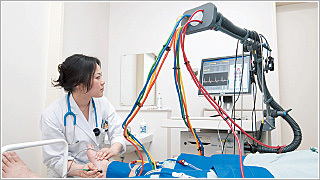Centers & Services
Top > Centers & Services > Central Clinical Services > Vascular Board
Vascular Board

Vascular diseases, particularly arteriosclerotic lesions, continue to proliferate due to the ageing population and changing lifestyle habits. These diseases are so varied that, increasingly, they cannot be adequately dealt with by contemporary medicine that specializes
into more and more specific subdivisions. The Vascular Board was established in 2006 to tackle this issue, so that vascular diseases can be
handled in a cross-sectoral and systematic manner within the hospital, going beyond boundaries of department or division. (Vascular Board is
a neologism of The University of Tokyo.).
Medical services
The Vascular Board sees the participation of physicians, nurses, and technicians engaged with vascular diseases, their assessment, and patient care. It aims to discuss vascular disease patients that cannot be handled by a single division or department, or issues related to the examination system, and to allow for a smooth cooperation among departments and job categories. The Board is managed by the Vascular Board Committee.
Treatment policy
It is said that around 30 per cent of the patients with lower limb ischemia present coronary lesions, and also tend to have concomitant complications such as cerebral infarctions. Arteriosclerosis indeed happens throughout the body.
Moreover, the blood of cancer patients and of patients using certain drugs (i.e. steroid) tend to be prone to form blood clots, which lead to a heightened risk of thrombosis. Post-operative thrombosis (pulmonary embolism) is a complication that can sometimes be fatal. All kinds of treatments including surgery are carried out in a university hospital like The University of Tokyo Hospital, giving rise to the need to care for complicated states of the body like the ones described above. Precisely because high-level medicine is making dramatic progresses by specializing, there is a need for cross-sectoral medicine. So that our patients can receive better and safer treatment, the Vascular Board aims to create a system that makes cooperation within the hospital smoother, and to analyze the hospital’s per formance in order to identify problems and implement improvements swiftly.
Major activities
- Data analysis and consultation regarding incidences of pulmonary embolism or deep thrombophlebitis in the hospital
- Multi-disciplinary conference on CLTI (chronic limb-threatening ischemia) [Limb Salvaging Foot care Team]
- Report on activities of the Heart Team [Heart Team]

Katsuyuki Hoshina
Departments/Divisions
Vascular Surgery
Titles
M.D., Ph.D.
Expertise/Specialties
Vascular Surgery
Research Interests
Abdominal aortic aneurysm, mechanical engineering, simulation, surgical education, drug delivery systeme
Languages
Japanese, English
